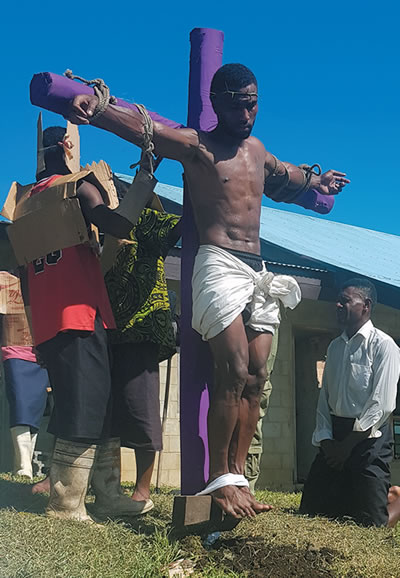
It has always struck me that the Fijian translation of Good Friday is simply and literally, “Day of Death.” No massaging, no theological euphemisms, just saying is “as it is.” In turn, preparations for this day are taken very seriously, and the crosswalks or the dramas with which they mark the day are often long, physically challenging, and emotional.
Such was the case with the five “highland” villages of Ba today, where 40 of whose youth had started carrying the cross in silence on Wednesday morning along the almost 20-mile stretch on the tough and parched roads linking their villages. They were accompanied by the parish catechists of each village (and often by youth of other Christian denominations) who gave teachings each night on the meaning of Holy Week.
Having bid goodbye to the parishioners of Ba Town at 6 a.m. as they boarded a bus to begin their own cross walk, and knowing that the other section of the parish (the four coastal villages) had also been on the road since 5 a.m., I headed up the hills to Navala, to first conduct five baptisms and the admission of twelve young people into our Sacrament of Confirmation Program.
By 9 a.m., we were ready to witness the highland youths’ rendering of the Passion of St. John, which was interwoven with the fourteen traditional Stations of the Cross. The lifelike shouts of the soldiers and physical mistreatment of Jesus abruptly brought us back to that day in Jerusalem some 2000 years ago.
Dressed in uniforms culled from cardboard boxes, except for the few wearing Fiji army fatigues, they pushed Jesus up the hill of the village, where he met his mother and the weeping women, fell and stood up again three times, was helped briefly by Simon of Cyrene, and was finally divested of his clothes right down to his undergarment, at which point he was hoisted over the village on a cross.